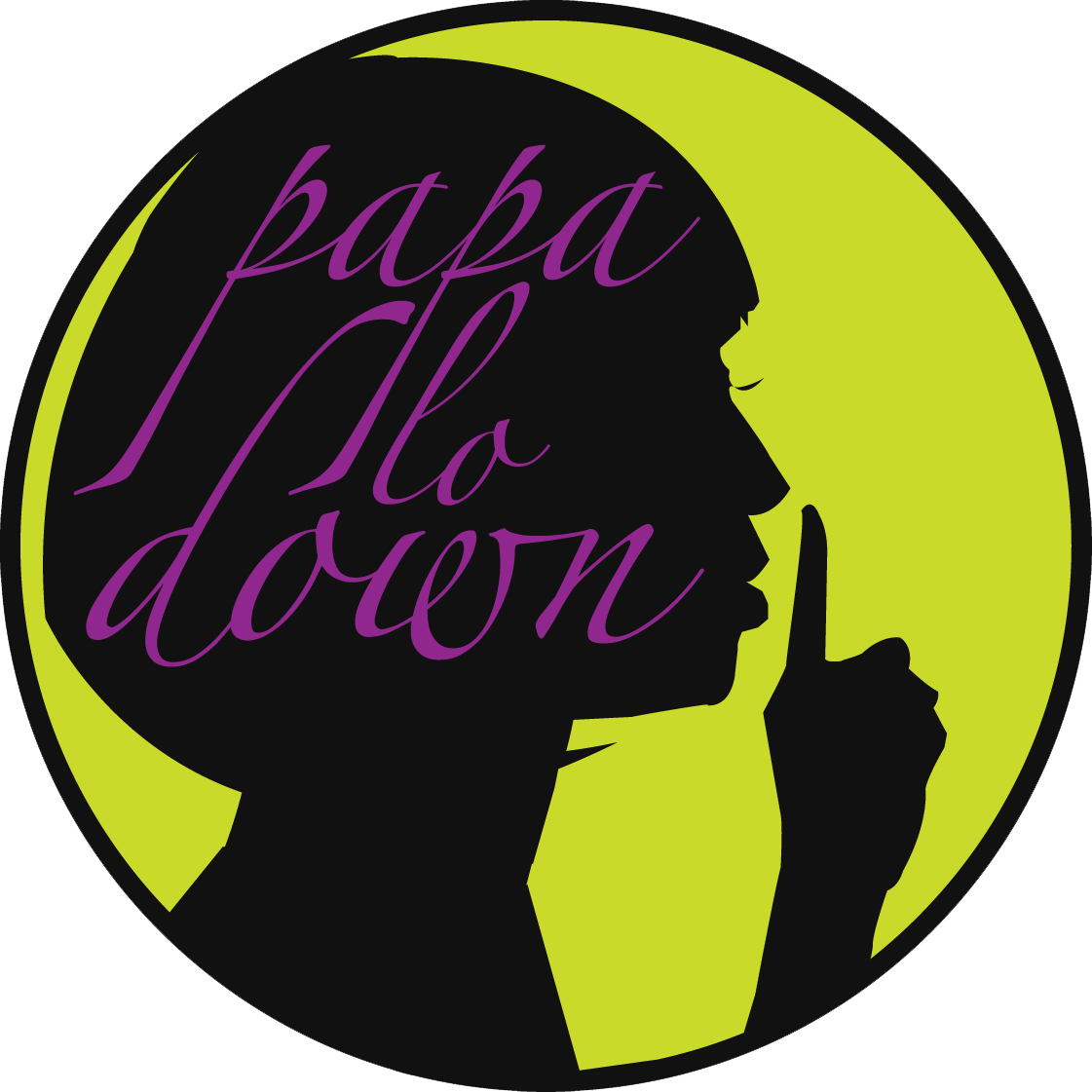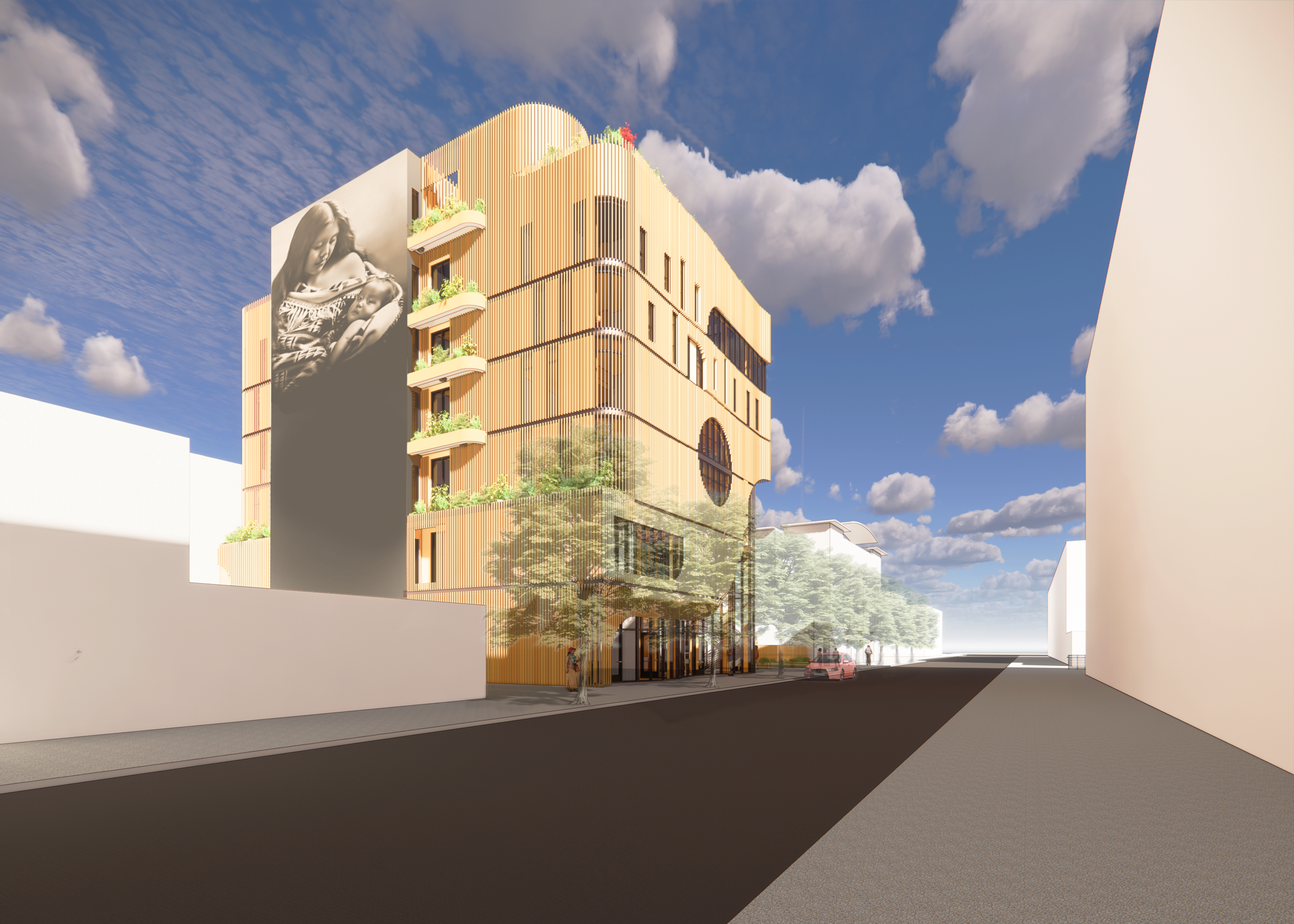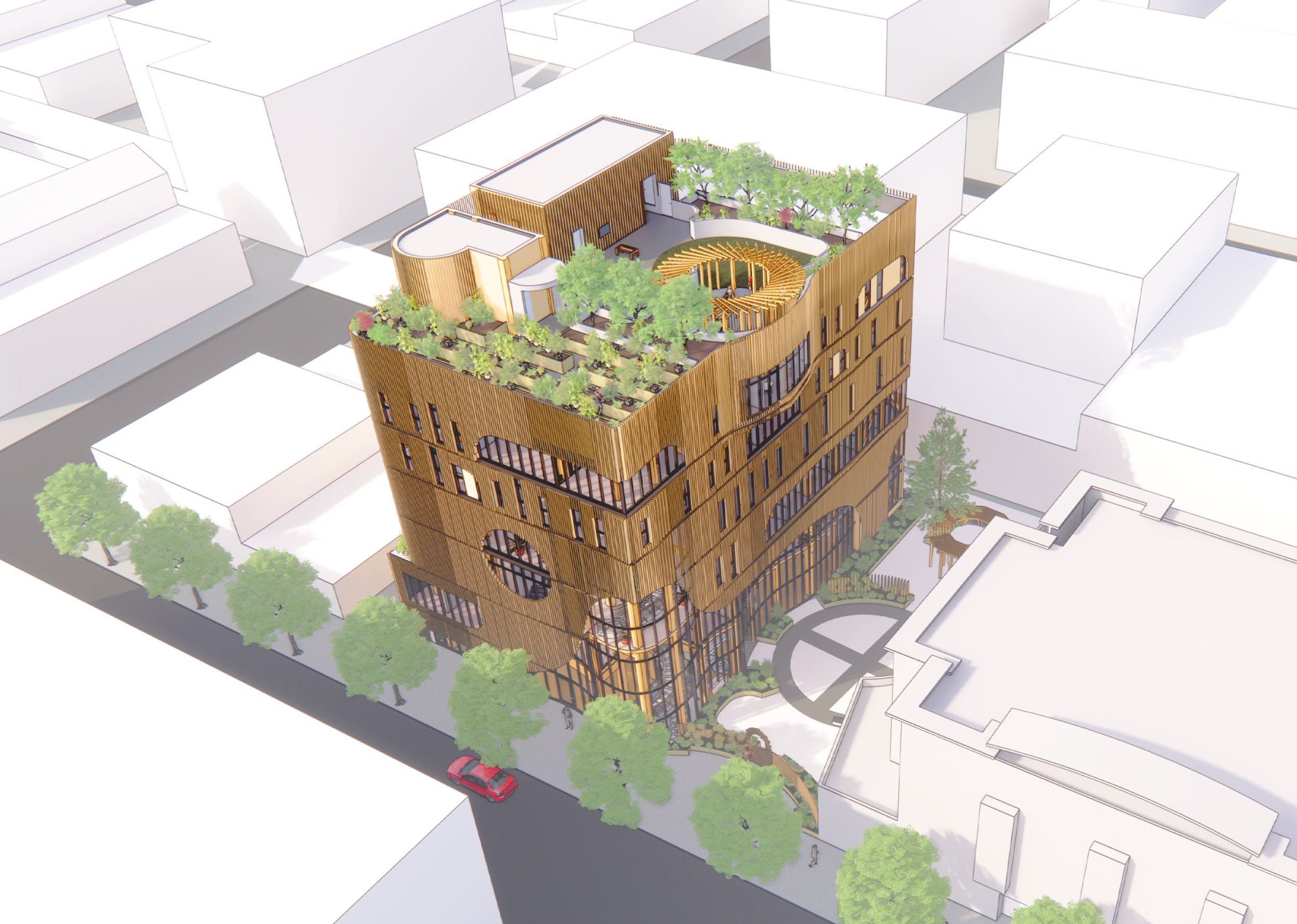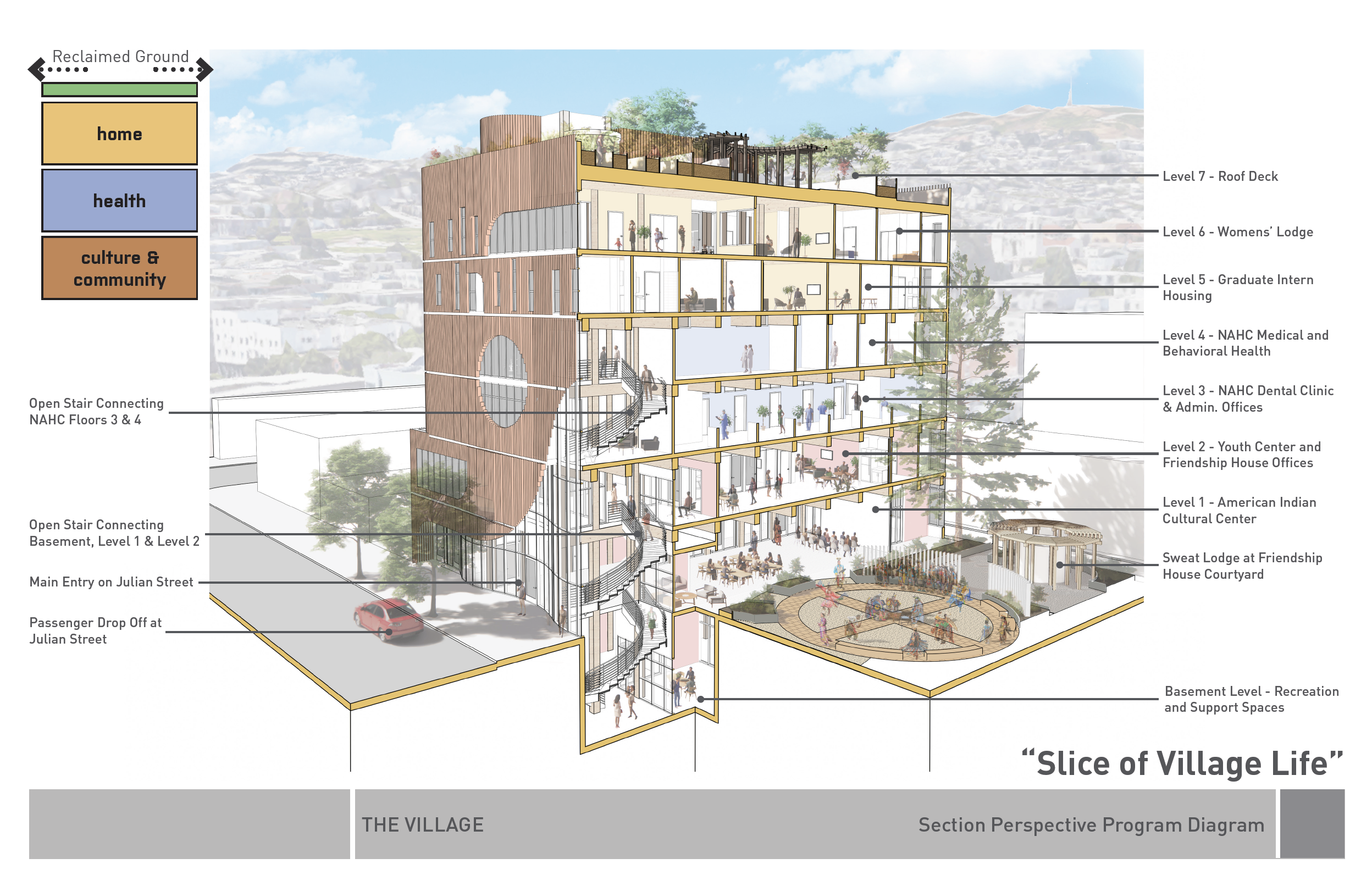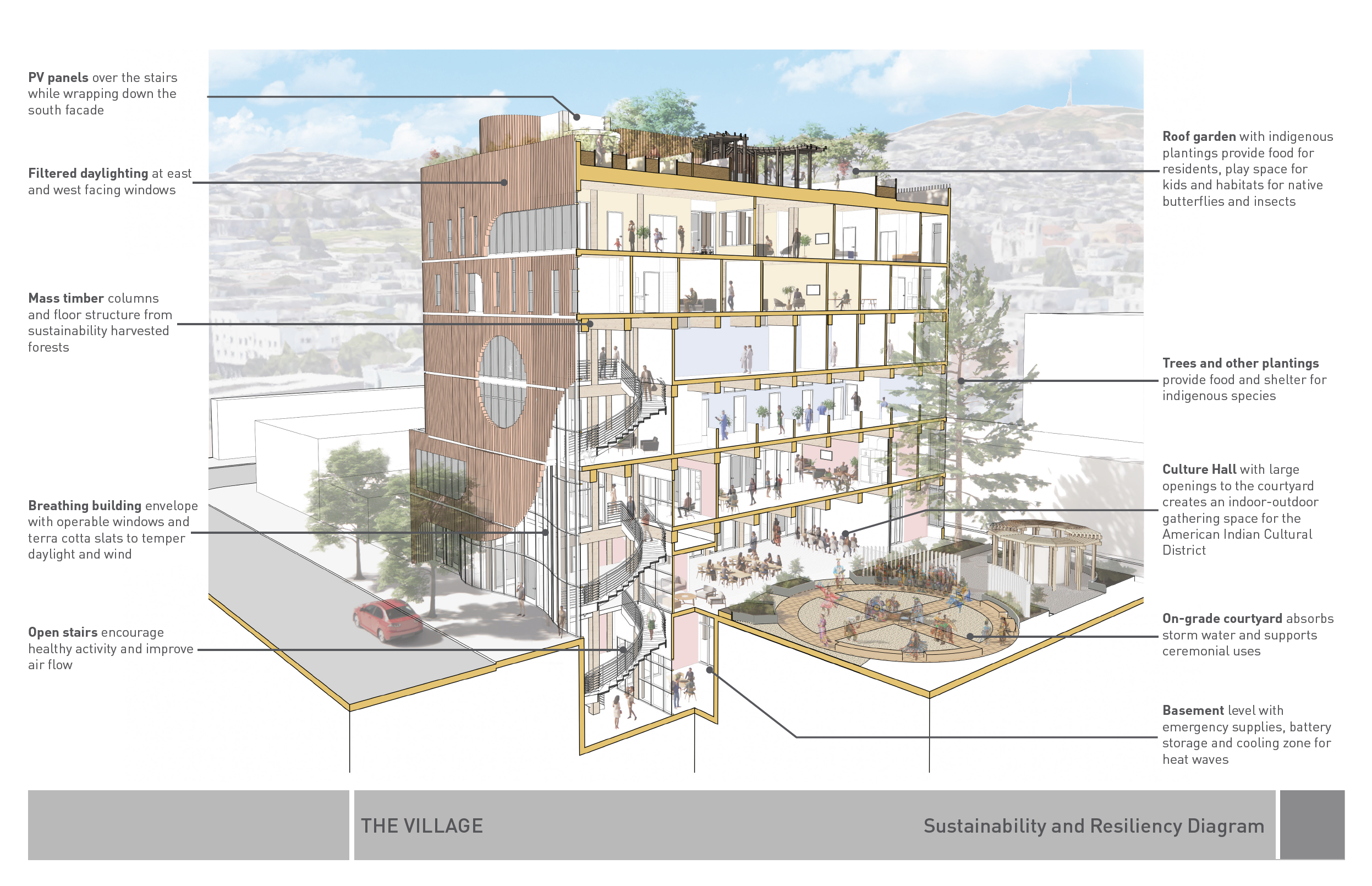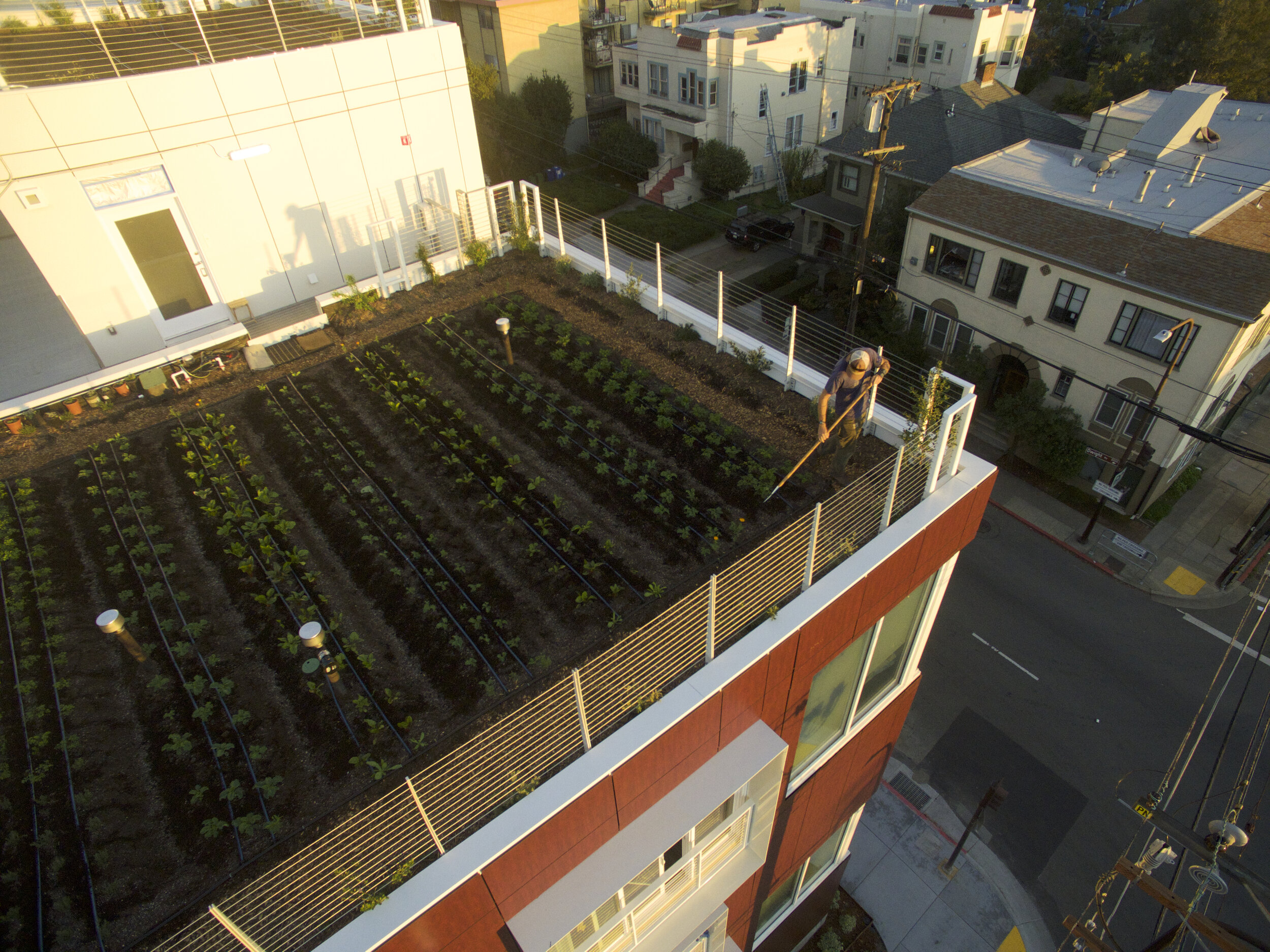The Village in San Francisco’s Mission District Goes Back to Indigenous Roots to Build the Future of Sustainable Urban Living
From ground to rooftop, the newly announced center for Native Americans living in
the city is being designed with indigenous principles of ecology, land stewardship and environmental justice
SAN FRANCISCO, CA - April 22, 2021 - By design, The Village San Francisco — a recently announced social services, cultural & spiritual center envisioned by an inter-tribal coalition of Native American organizations, led by The Friendship House Association of American Indians — is increasing opportunities for American Indians living in the city to access public green space. The team intends to build the six-story landmark — which is to anchor San Francisco’s American Indian Cultural District — as a living example of centering traditional Indigenous values, connection to land, culture & identity with principles of sustainability, ecology and resiliency in the fight for environmental justice. The crown jewel of the project is a 4,000 square foot rooftop sustainable farm space. Key design partners in this radical effort include Top Leaf Farms, Pyatok Architecture + Urban Design and Equity Community Builders.
“It’s really an exciting moment to be able to envision a living space in the middle of a city that’s actually a healing space because so many of our living spaces create spaces of isolation for people and make it very hard to connect not only with each other, but between ourselves and the natural world around us,” says Dr. Rupa Marya, Top Leaf Farms Co-Founder and Director of Social Impact and Operations, physician, teacher and musician.
An Interconnected, Inter-Tribal Coalition
A core pillar of The Village San Francisco is the interconnected partnership among Native-led organizations and other community supporters. This web of partners is dedicated to environmental justice and a growing policy advocacy movement that seeks to recognize American Indians living in cities and to transform Western social service practices to better serve Black, Indigenous and People of Color, providing a model for building equitable communities.
The all-Native coalition includes:
Other key partners:
San Francisco Mayor's Office of Housing & Community Development
Former Representative Harold Mitchell
Edgar Villanueva, Senior VP of Programs & Advocacy at Schott Foundation and author of “Decolonizing Wealth”
Rooftop farm image provided by Top Leaf Farms
A Living, Breathing Building in the Web of Life
The Village San Francisco is a “living building,” intended to serve over 6,000 Native Americans living in the city and to renew their ancestral kinship with the Earth and other life elements — one which values interconnectedness, individual and collective responsibility, and living in balance with all creation. The center is designed to foster a greater ecosystem of relationships in a regenerative and sustainable manner and to coexist within its urban environment through select features including:
Urban agricultural rooftop farm: To honor the first inhabitants, the Village lifts up the earth, becoming a rooftop landscape that supports native plants and animals, collects rainwater, and provides sustainable energy for the building and its inhabitants. This new ground is where youth, elders, and the Village community share stories and renew their connection to the sky, the sun, the hills, and the bay.
Timber Frame: The Village is supported by a framework of composite wood posts, beams, and planks; materials naturally generated from sunlight, air, water, and earth. The mass timber construction is exposed on the interior to create a warm environment and reduce the use of additional interior finishes. Mass timber is sourced from sustainable forests and stores that carbon for the life of the Village.
Woven Skin: The building cladding is a layered exterior that maximizes daylighting and cross ventilation. This breathing skin consists of floor-to-ceiling operable windows protected by a lattice of natural terra cotta fins that modulate wind and direct sunlight. These elements are intertwined and patterned akin to indigenous buildings and basket weaving. Vegetation incorporated into recessed alcoves weaves itself into this layered façade, further expressing a living and breathing building.
Communal Stair: Open curving stairways connect the three levels of the Cultural Center and the two levels of the Native American Health Clinic, inviting inhabitants to bi-pass the elevator and experience the tall east-facing windows and native artwork. These stairways promote healthy exercise and social interaction. They also embody native traditions of ascending to the Milky Way to access the spirit world.
Cycle of Water: The Ramaytush Ohlone peoples thrived sustainably for thousands of years on the rainwater that fed Mission Creek. Restoring this connection to local sources, collected rainwater irrigates native plantings and provides recycled water for building uses. The story of water collection and re-use is visible throughout the building in rainwater gardens, visible conveyance, and porous surfaces that allow overflow from the roof to percolate back into the ground.
Healing Surfaces: Supporting the Village's mission of deep-healing, every interior surface is selected to be healthy to the touch and to support healthy indoor air. Interior materials connect to indigenous traditions, reduce the burden on the natural resources of the earth, and can be recycled when replaced.
Fossil Free Energy: Solar panels wrap up the south-facing façade and onto the roof, converting sunlight into electricity that feeds the all-electric building and on-site battery storage. The solar panels are woven into the fabric of the building on the south façade. The on-site battery story adds resiliency to the Village enabling it to be a community resource and refuge.
Community Shelter: The Village is a refuge in times of need. The structure and systems are designed to provide shelter in the event of disruptions in daily life. The timber frame is designed to survive earthquakes and fire. The deep basement provides space for battery storage, emergency supplies, and cooling centers during heat spells.
Technology and Teaching: State of the art and user friendly technology ties together all the Village elements that allow occupants to manage and monitor the health and well-being of the Village as part of an ecological system. Real time feedback for each level allows occupants to manage energy usage, temperature and air quality. Technology will also provide an interactive teaching device to allow youth and all Village members to participate in the sustainable management of the building.
Leadership: As a model project for urban sustainability, the Village draws guidance and inspiration from multiple sustainability standards, including the International Living Futures Institute's Living Building Challenge, the Living Products Challenge, and the AIA 2030 Challenge. Metrics and goals will be established and tracked to create a database that becomes a resource for future projects.
Through storm water management and rehydration systems, ground-level landscaping has a relationship with the rooftop farm that further encourages vegetation to grow on the entirety of the building. The Village is effectively creating an “island of biodiversity,” as described by Top
Leaf Farms co-founders Dr. Rupa Maryra and Benjamin Fahrer, that offers habitat to pollinators, beneficial insects, birds and healthy microbial life.
“This innovative model seeks to offer holistic and culturally appropriate support while walking softer on Mother Earth and contributing next-level solutions to the growing Indigenous urban agriculture movement,” says Keir Johnson (Osage Nation) of the Intertribal Agriculture Council.
Rewilding Urban Spaces for Food and Environmental Justice:
The economic systems of European settler-colonialism and racial capitalism have required the extraction of Indigenous land and people, labor and life, leading to the displacement, genocide and cultural erasure of America’s First Peoples. The United States’ termination and relocation policies of the 1950s and 1960s continued to reinforce this mission of settler society by forcing Native Americans to assimilate into cities. This history has resulted in a severing of the Indigenous relationship to the land and to their traditional ways of living, the consequences of which still reverberate today.
While the majority of American Indians live in or near cities, they are one of the least likely groups to have access to green space and public land let alone their homelands. This lack of access to nature has negative consequences on mental and physical health and leaves urban Native Americans, like other communities of color, vulnerable to the impact of climate change and industrial development.
Additionally, while the COVID-19 pandemic has shown the importance of green space to people’s overall physical and emotional wellbeing, the U.S. has systematically segregated and excluded Black, Indigenous and other communities of color from these spaces.
The Village San Francisco’s inherently green design offers a contemporary framework for and first steps toward environmental equity for Native Americans living in or near urban centers. Moreover, The Village San Francisco reestablishes a sacred space and a community homebase, fundamental to the health and well-being of the people it serves.
The project will also set a precedent for urban agriculture, specifically through its rooftop farm, as a means to tackle the many challenges prevalent in today’s cities. Bringing soil and food plant systems into the urban environment can provide multiple tangible benefits including reduced heat island effect, reduced municipal stormwater loads, local healthy food, community building, healthier living, reduced vehicular food distribution impacts, local jobs and additional local resource-driven revenue.
With direction of Top Leaf Farms, the landscaping, green roof and farm aspects of this project are intended to represent a long-term commitment and investment in local urban agriculture, as well as The American Indian Cultural District’s (AICD) commitment to sustainability.
Dauwila Harrison (Pomo/Paiute/Navajo) and Randy Shirley
Resiliency: Emergency Readiness and Responsiveness
In response to COVID-19, Friendship House in collaboration with Native American Health Center and MeWater Foundation, launched a Wellness Check-In Program which coordinated the purchase and drop-off of school supplies, cleaning supplies, hand sanitizer, face masks, and food boxes to American Indian youth and families. The team also regularly checked in with community members to provide academic support, family engagement, and referrals to additional resources.
This experience inspired the team to add a Native Emergency Readiness Center to The Village framework to provide a dedicated response to both social and environmental emergencies. The Village will provide shelter and resources in times of need in ways culturally relevant to Native Americans. The center will also serve as a "warming/cooling center" for American Indians who are on low/fixed incomes during cold/hot spells.
“Yes, we want our community, our elders and youth, to be able to touch the earth, put their hands in the soil, and experience the miracle of planting a seed and watching it grow,” said Peter Bratt, filmmaker and The Village project lead. “But many of our ceremonies and cultural practices — including our deep ties to the land, plants and traditional foods — were deliberately and systematically disrupted. So we’re also trying to mend a relationship that has been broken and is in need of some nurturing, love, and repair.”
By honoring timeless Indigenous values while being future-forward, The Village San Francisco ultimately is a radical vision of resilience and healing brought to life for Native Americans living in urban centers. The Village will be a living example for other cities of Indigenous dignity and self-determination, building toward a culture of care and the restoration of balance.
###
About The Village San Francisco:
The Village San Francisco is an inter-tribal community coalition of Native organizations and groups that serve San Francisco’s Indigenous population. Together, we are creating a physical, service, cultural and spiritual center for American Indians that will provide access to health care services, cultural resources, green space, housing and a place to thrive, ensuring the well-being of our people seven generations from now. The cultural landmark is to anchor the first American Indian Cultural District of its size ever designated in the United States, centered in the Mission District’s 16th Street Corridor. The majority of Indian people live in cities, yet we remain an invisible community and share similar disparities of other communities of color. The Village is a 21st Century solution to a 21st Century reality – namely, that we are urban, inter-tribal, and without a physical or cultural home. The Village is visionary in establishing a home place that provides community connection and essential services by and for urban American Indians.
The Village Coalition & Key Partners:
Inter-Agency Coalition
Friendship House Association of American Indians — the oldest social service organization in the United States run by and for American Indians. Over the last 50 years, Friendship House has helped more than 4,800 residential clients overcome substance abuse, empowered hundreds of youth, and provided community events for countless individuals and families.
Native American Health Center — One of the largest health care delivery systems serving American Indians in the country.
American Indian Cultural Center – A community art and culture center, providing American Indians a place to gather, celebrate, have ceremony, create and thrive.
American Indian Cultural District — Founded on March 31st, 2020, the American Indian Cultural District (AICD) is the first established cultural district of its size in the United States dedicated to recognizing, honoring, and celebrating the American Indian legacy, culture, people, and contributions.
SFUSD’s Indian Education, Title VII Program (in conjunction with the FH Youth Program) – City government community support working in alliance with community partners to meet the unique educational and culturally related academic needs of American Indian/Alaska Native students as it connects to their cultural, emotional, and social wellbeing in the SF Unified School District.
The Women’s Lodge — A culturally based treatment program that allows Indigenous mothers to go through recovery with their children.
Project Team
Helen Waukazoo (Navajo), Abby Abinanti (Yurok), Nelson Jim (Navajo), Anthony Tam, Dauwila Harrison (Pomo/Paiute/Navajo) and Peter Bratt (Quechua) of Friendship House Association of American Indians
Suzanne Brown of Equity Community Builders
Karin Johnston & April Ang of HMS Associates
Lawrence Badiner of Badiner Urban Planning
Pyatok Architecture and Urban Designs — PYATOK works to foster the development of vibrant, sustainable, inclusive communities through sensitive architecture and urban design, education, service and technical innovation.
Miguel Gavaldon, Fund Development Consultant
PapaLoDown Agency — The PapaLoDown Agency is a boutique public relations company in the San Francisco Bay Area, specializing in BIPOC-owned businesses and organizations.
Top Leaf Farms — A restorative practice with a farmer-led design team creating built environment food system solutions that are productive, beautiful and resilient in the face of climate change.
Key Partners
The Intertribal Agriculture Council — The Intertribal Agriculture Council was founded in 1987 to pursue and promote the conservation, development and use of our agricultural resources for the betterment of Native people.
IllumiNative — Created & led by Native peoples, IllumiNative is a national nonprofit dedicated to increasing the visibility of Native Nations & peoples in America.
The Office of Kat Taylor — an impact investor, Co-Founder of The Good Life Pledge, nonprofit board member, mission-driven community bank CEO, and philanthropist working in the service of restoring social justice and environmental well-being. Currently, she serves as Co-Founder and Board Chair of Beneficial State Bank and is a Founding Director of TomKat Ranch Educational Foundation (TKREF), dedicated to inspiring a sustainable food system through ranching, training, tours, research, and school food and garden programs.
Full Spectrum Capital Partners — Through their partnership, Full Spectrum Labs, Impact Finance Center and Dev Labs Venture Fund collaborate to build ecosystems and marketplaces for innovation that lift up solutions and leaders emerging from communities that have been marginalized historically.
Former Representative Harold Mitchell
The Women’s Foundation California — A statewide, publicly supported foundation dedicated to achieving racial, economic, and gender justice by centering the experience and expertise of communities most impacted by systemic injustice.
San Francisco Mayor's Office of Housing & Community Development — MOHCD supports residents with affordable housing opportunities and essential services to build strong communities and has been partnering with the Friendship House for many years. Additionally, through its Cultural Districts program, MOHCD is proud to support the American Indian community’s vision for self-determination and their policy strategies to strengthen their community infrastructure.
Edgar Villanueva, Senior VP of Programs & Advocacy at Schott Foundation and author of “Decolonizing Wealth”
